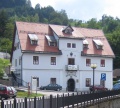Mercury mining heritage
For centuries Idrija with its mercury mine was considered to be the centre of scientific and technological progress in the region. History of mining in Idrija dates back to year 1490. By burning cinnabar ore, the mercury miners of Idrija mined over 13 per cent of the world production of this ore. It was the second oldest and biggest mercury mine in the world that had closed in 1995 due to commercial, geological and ecological reasons. Only Almadén mercury mine in Spain is bigger and dates back to Roman times. Both towns were so famous that their names were used in North America for mining towns of New Idria and New Almadén. Until first world war Idrija Mercury Mine was one of the best technically equipped mine in Europe. Company is still nowadays in closing procedure, because it has to rehabilitate the consequences of 500 year mining, that is to secure the shafts and to monitor the poisoning of the environment.
In 2007 the intercontinental Mercury Route, the so-called Camino Real, going through Almadén Spain to Mexico and other parts of American continents was presented for the inclusion in the UNESCO World Heritage list. The route had commercial, technical and lifestyle specifics connected with mining and trade still eminent after 500 years. After the first nomination, in 2011 the new nomination was prepared by Idrija and Almadén.
Articles in category "Mercury mining heritage"
The following 11 pages are in this category, out of 11 total.
Media in category "Mercury mining heritage"
The following 12 files are in this category, out of 12 total.
- Film Theatre Idrija 2014 Miners Theatre.JPG 1,920 × 1,080; 759 KB
- Idrija Mine Museum 2006 entrance.jpg 1,299 × 1,173; 218 KB
- Idrija Mine Museum 2011 Photo Stephen Colebourne.jpg 4,000 × 2,248; 1.91 MB
- Miner's House Idrija 2007 bread stove tools.JPG 1,536 × 2,048; 334 KB
- Miner's House Idrija 2007 closet.JPG 1,536 × 2,048; 341 KB
- Miner's House Idrija 2007 fireplace.JPG 2,048 × 1,536; 395 KB
- Miner's House Idrija 2007.JPG 1,536 × 2,048; 442 KB
- Miner's House Idrija 2007 lace making table.JPG 1,536 × 2,048; 337 KB
- Miner's House Idrija 2007 sink.JPG 1,536 × 2,048; 418 KB
- Municipality of Idrija 1689 Valvasor.jpg 955 × 768; 187 KB
- Municipality of Idrija 1840.jpg 793 × 576; 816 KB
- Municipality of Idrija 2008.jpg 1,600 × 1,200; 1.31 MB














